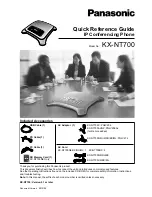
Engineering Guidelines
134
CESID AUTO UPDATES, UNSUPPORTED CONFIGURATIONS
Automatic updating of CESID when a phone moves to a new location will
not
work under the
following circumstances:
•
If the IP phone is connected to an Ethernet hub
•
If the IP phone is connected to an L2 switch that does not have CDP or STP/RSTP enabled
•
If multiple IP phones report connectivity to the same L2 port. The system will detect this
condition upon device registration.
The following examples of network configuration should
not
be used in an installation that
requires E911 services:
•
Some L2 switches use CDP and others use STP/RSTP (see Figure 14 below). The problem
with this network configuration is that the 3300 ICP could receive information from
STP/RSTP that conflicts with information received from CDP. Since the ICP is not receiving
data for all ports from both protocols, conflicts cannot be resolved.
•
Some or all L2 switches have both CDP and STP/RSTP disabled (see Figure 15 on
page 135) or sets are connected to an L2 switch via a hub (see Figure 16 on page 135).
From the perspective of the 3300 ICP, it will appear that several devices are all plugged
into the same L2 port (i.e. the port of the L2 switch that is one step higher in the network
tree). For E911 to function correctly, an IP phone should be associated with only one L2
port MAC address.
Figure 14: Non-compatible Network Configuration -
Access L2 Switches have Mixed Protocol Configurations
Summary of Contents for MiVOICE BUSINESS
Page 1: ...Mitel MiVoice Business RELEASE 7 2 ENGINEERING GUIDELINES ...
Page 15: ...Chapter 1 ABOUT THIS DOCUMENT ...
Page 16: ......
Page 22: ...Engineering Guidelines 8 ...
Page 23: ...Chapter 2 SYSTEM OVERVIEW ...
Page 24: ......
Page 28: ...Engineering Guidelines 14 ...
Page 29: ...Chapter 3 TYPICAL CONFIGURATIONS ...
Page 30: ......
Page 73: ...Chapter 4 PHONES AND VOICE APPLICATIONS ...
Page 74: ......
Page 95: ...Phones and Voice Applications 81 Figure 9 ICP Connection Paths and Limitations ...
Page 100: ...Engineering Guidelines 86 ...
Page 101: ...Chapter 5 POWER ...
Page 102: ......
Page 128: ...Engineering Guidelines 114 ...
Page 129: ...Chapter 6 PERFORMANCE ...
Page 130: ......
Page 135: ...Chapter 7 APPLICATIONS ...
Page 136: ......
Page 142: ...Engineering Guidelines 128 ...
Page 143: ...Chapter 8 EMERGENCY SERVICES ...
Page 144: ......
Page 151: ...Chapter 9 IP NETWORKING ...
Page 152: ......
Page 167: ...Chapter 10 LICENSING ...
Page 168: ......
Page 183: ...Chapter 11 BANDWIDTH CODECS AND COMPRESSION ...
Page 184: ......
Page 209: ...Chapter 12 NETWORK CONFIGURATION CONCEPTS ...
Page 210: ......
Page 244: ...Engineering Guidelines 230 ...
Page 245: ...Chapter 13 NETWORK CONFIGURATION SPECIFICS ...
Page 246: ......
Page 309: ...Appendix A CAT 3 WIRING ...
Page 310: ......
Page 315: ...CAT 3 Wiring 301 Figure 55 CX MX MXe AX and LX Minimum Cable Standard ...
Page 316: ...Engineering Guidelines 302 ...
Page 317: ...Appendix B INSTALLATION EXAMPLES ...
Page 318: ......
Page 335: ...Appendix C LLDP AND LLDP MED CONFIGURATION EXAMPLES ...
Page 336: ......
Page 347: ...Appendix D VOIP AND VLANS ...
Page 348: ......
Page 353: ...Appendix E VOIP SECURITY ...
Page 354: ......
Page 381: ... ...
















































